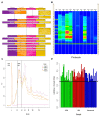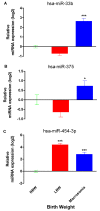Analysis of MicroRNA Expression in Newborns with Differential Birth Weight Using Newborn Screening Cards
- PMID: 29182561
- PMCID: PMC5751155
- DOI: 10.3390/ijms18122552
Analysis of MicroRNA Expression in Newborns with Differential Birth Weight Using Newborn Screening Cards
Abstract
Birth weight is an early predictor for metabolic diseases and microRNAs (miRNAs) are proposed as fetal programming participants. To evaluate the use of dried blood spots (DBS) on newborn screening cards (NSC) as a source of analyzable miRNAs, we optimized a commercial protocol to recover total miRNA from normal birth weight (NBW, n = 17-20), low birth weight (LBW, n = 17-20) and high birth weight (macrosomia, n = 17-20) newborns and analyzed the relative expression of selected miRNAs by stem-loop RT-qPCR. The possible role of miRNAs on the fetal programming of metabolic diseases was explored by bioinformatic tools. The optimized extraction of RNA resulted in a 1.2-fold enrichment of miRNAs respect to the commercial kit. miR-33b and miR-375 were overexpressed in macrosomia 9.8-fold (p < 0.001) and 1.7-fold, (p < 0.05), respectively and miR-454-3p was overexpressed in both LBW and macrosomia (19.7-fold, p < 0.001 and 10.8-fold, p < 0.001, respectively), as compared to NBW. Potential target genes for these miRNAs are associated to cyclic-guanosine monophosphate (cGMP)-dependent protein kinase (PKG), mitogen-activated protein kinase (MAPK), type 2 diabetes, transforming growth factor-β (TGF-β)and Forkhead box O protein (FoxO) pathways. In summary, we improved a protocol for analyzing miRNAs from NSC and provide the first evidence that birth weight modifies the expression of miRNAs associated to adult metabolic dysfunctions. Our work suggests archived NSC are an invaluable resource in the search for fetal programming biomarkers.
Keywords: birth weight; circulating microRNAs; fetal programming; newborn screening cards.
Conflict of interest statement
The authors declare no conflict of interest.
Figures



Similar articles
-
MicroRNA in dried blood spots from patients with Aagenaes syndrome and evaluation of pre-analytical and analytical factors.Pediatr Res. 2021 May;89(7):1780-1787. doi: 10.1038/s41390-020-01153-3. Epub 2020 Sep 15. Pediatr Res. 2021. PMID: 32932426
-
Preparation and processing of dried blood spots for microRNA sequencing.Biol Methods Protoc. 2023 Sep 20;8(1):bpad020. doi: 10.1093/biomethods/bpad020. eCollection 2023. Biol Methods Protoc. 2023. PMID: 37901452 Free PMC article. Review.
-
Circulating microRNAs overexpressed in macrosomia: an experimental and bioinformatic approach.J Dev Orig Health Dis. 2020 Oct;11(5):464-472. doi: 10.1017/S2040174420000422. Epub 2020 May 26. J Dev Orig Health Dis. 2020. PMID: 32452339
-
microRNAs in newborns with low birth weight: relation to birth size and body composition.Pediatr Res. 2022 Sep;92(3):829-837. doi: 10.1038/s41390-021-01845-4. Epub 2021 Nov 19. Pediatr Res. 2022. PMID: 34799665
-
Regulation of the MIR155 host gene in physiological and pathological processes.Gene. 2013 Dec 10;532(1):1-12. doi: 10.1016/j.gene.2012.12.009. Epub 2012 Dec 14. Gene. 2013. PMID: 23246696 Review.
Cited by
-
Obesity in male volcano mice Neotomodon alstoni affects the daily rhythm of metabolism and thermoregulation.Front Nutr. 2022 Aug 4;9:963804. doi: 10.3389/fnut.2022.963804. eCollection 2022. Front Nutr. 2022. PMID: 35990356 Free PMC article.
-
MicroRNA in dried blood spots from patients with Aagenaes syndrome and evaluation of pre-analytical and analytical factors.Pediatr Res. 2021 May;89(7):1780-1787. doi: 10.1038/s41390-020-01153-3. Epub 2020 Sep 15. Pediatr Res. 2021. PMID: 32932426
-
Preparation and processing of dried blood spots for microRNA sequencing.Biol Methods Protoc. 2023 Sep 20;8(1):bpad020. doi: 10.1093/biomethods/bpad020. eCollection 2023. Biol Methods Protoc. 2023. PMID: 37901452 Free PMC article. Review.
-
Gut Microbiome and Small RNA Integrative-Omic Perspective of Meconium and Milk-FED Infant Stool Samples.Int J Mol Sci. 2023 Apr 29;24(9):8069. doi: 10.3390/ijms24098069. Int J Mol Sci. 2023. PMID: 37175775 Free PMC article.
-
Identification of microRNA signatures in umbilical cord blood associated with maternal characteristics.PeerJ. 2019 May 30;7:e6981. doi: 10.7717/peerj.6981. eCollection 2019. PeerJ. 2019. PMID: 31179182 Free PMC article.
References
-
- World Health Organization Promoting Optimal Fetal Development: Report of a Technical Consultation. [(accessed on 15 July 2014)];2006 Available online: http://www.who.int/nutrition/publications/fetomaternal/9241594004/en/
-
- Ramadhani M.K., Grobbee D.E., Bots M.L., Castro-Cabezas M., Vos L.E., Oren A., Uiterwaal C.S. Lower birth weight predicts metabolic syndrome in young adults: The Atherosclerosis risk in young adults (ARYA)-study. Atherosclerosis. 2006;184:21–27. doi: 10.1016/j.atherosclerosis.2005.03.022. - DOI - PubMed
MeSH terms
Substances
LinkOut - more resources
Full Text Sources
Other Literature Sources
Medical

